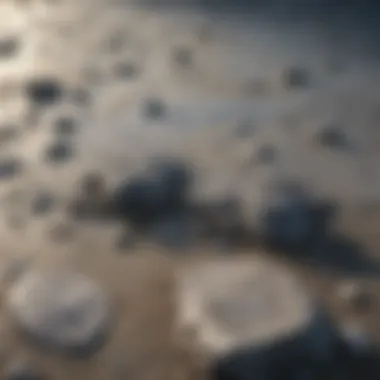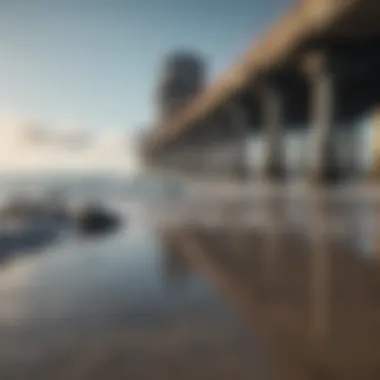Innovative Ocean Concrete: Transforming Coastal Construction


Intro
The world’s oceans cover a staggering 71% of the Earth’s surface, holding untold secrets beneath their shimmering waves. Yet, as humankind increasingly turns to these vast bodies for development and resource extraction, the need for sustainable innovation has never been clearer. One breakthrough making waves of its own is ocean concrete—a specialized material tailored specifically for marine environments. This article dives deep into the science, applications, and implications of ocean concrete, illuminating how it stands at the intersection of engineering prowess and ecological sensitivity.
Diving into the subject, we will explore the characteristics that differentiate ocean concrete from its land-based counterparts, emphasizing its resilience to the corrosive challenges posed by saltwater environments. Additionally, it’s essential to dissect how this material can reshape coastal construction and infrastructure. Each section, be it examining the research background or the methodologies behind ongoing studies, aims to foster a comprehensive understanding, making a case for why ocean concrete is not merely a construction material—it’s a catalyst for sustainable development.
"The ocean is not just a resource; it's a reservoir of potential—if we choose to innovate responsibly."
Our journey into ocean concrete will reveal its myriad applications, from supporting marine life to influencing coastal durability. We’ll tackle the pressing challenges faced by professionals in the field, navigating through both the innovative solutions and the hurdles yet to be crossed. As we progress, let’s engage with the profound questions surrounding its environmental implications and long-term viability.
Now, let’s formally establish the Research Context that frames our exploration of ocean concrete.
Intro to Ocean Concrete
The exploration of ocean concrete is not just a fringe topic; it's a crucial aspect of modern civil engineering and construction practices. The unique challenges posed by marine environments demand innovative solutions. Ocean concrete stands out as an exceptional material specifically crafted to endure the harsh conditions of coastal regions. In this section, we will break down the definition and historical significance of this intriguing material, emphasizing its relevance in contemporary infrastructure projects.
Defining Ocean Concrete
When we talk about ocean concrete, we’re referring to a specialized type of concrete designed to thrive in salty and wet conditions. This isn’t your run-of-the-mill concrete. Instead, it is often formulated with unique additives and aggregates to improve its strength and resistance to corrosion. The blend typically includes specific minerals that reflect the specific conditions of the marine environment, thereby enhancing durability.
In essence, ocean concrete is built to withstand the wear and tear from waves, tidal forces, and saltwater, which can degrade conventional concrete in a surprisingly short time. While standard concrete may last years with general wear, ocean concrete is engineered to extend that lifespan significantly, minimizing maintenance and replacement costs over time.
Historical Context
The history of ocean concrete traces back to the needs of early civilizations that began constructing coastal structures. Ancient Romans, for instance, experimented with various mixtures to enhance the performance of their maritime structures, laying the groundwork for what we now refer to as ocean concrete. Fast forward to the 20th century, when researchers began conducting rigorous tests on concrete mixtures to create more resilient forms suitable for marine use.
This historical evolution reflects a growing understanding of the complex interactions between concrete and oceanic conditions. Contemporary research has been pivotal in refining formulations that meet current and future demands, making ocean concrete an essential material in projects such as harbors, piers, and seawalls. As we advance, this history informs ongoing innovations, drawing lessons from both successful and failed attempts to ensure that the right materials are used in the right situations.
"The development of materials suitable for marine environments marks a cornerstone in coastal construction, bridging ancient techniques and modern engineering."
In summary, ocean concrete is not simply a modern invention; it represents centuries of adaptation and innovation, evolving in response to the unique challenges posed by our oceans. Its importance in infrastructure not only speaks to its physical properties but also highlights our ongoing journey to better understand and adapt to our surrounding environment.
Physical and Chemical Properties
Understanding the physical and chemical properties of ocean concrete is vital for numerous reasons. First and foremost, these properties dictate how the material interacts with its marine environment. Factors such as salinity, temperature fluctuations, and wave action play a significant role in determining the longevity and efficacy of structures built with this concrete. Moreover, by analyzing these properties, engineers can tailor formulations to mitigate potential weaknesses, ensuring that ocean concrete can withstand the harsh realities of its surroundings.
Composition of Ocean Concrete
The composition of ocean concrete sets it apart from conventional concrete used in terrestrial applications. Typically, it includes a blend of traditional ingredients like cement, water, and aggregates, but with crucial modifications to enhance durability in marine environments. This can involve the use of mineral admixtures such as volcanic ash or silica fume, which serve not only to boost strength but also to improve workability.
In addition to these traditional elements, ocean concrete often incorporates specialized additives that confer unique properties. One such additive might be chloride-resistant admixtures, which help combat the corrosive effects of saltwater.
- Key components of ocean concrete include:
- Corrosion inhibitors to protect embedded steel from rusting
- Polymer modifiers that improve flexibility and adhesion
- Lightweight aggregates that reduce overall density while increasing strength
By tweaking these ingredients, developers aim to produce ocean concrete that offers not just structural integrity but also resistance against the onslaught of marine conditions.


Durability Against Marine Conditions
When it comes to durability, ocean concrete faces unique challenges that require a distinct approach. Its primary threats include corrosion, freeze-thaw cycles, and biofouling—each capable of degrading the material's structure over time. Engineers and scientists continually assess how these factors influence performance, adapting designs accordingly.
"It's not just about pouring concrete. It's about outsmarting the sea and its relentless forces."
One major advancement is the focus on high-performance concrete tailored to suit oceanic conditions. This type of concrete utilizes advanced materials and cutting-edge blending techniques to resist the issues associated with saltwater exposure.
In practical terms, durability studies have shown that ocean concrete can last significantly longer than standard mixes when properly designed and installed. For instance, the use of alkali-silica reaction (ASR) resistant aggregates minimizes the expansive pressures that can occur in a marine climate.
Additionally, regular inspections and maintenance protocols are vital to prolonging the life of ocean concrete structures. Such efforts ensure that issues can be mitigated before they escalate, safeguarding investments and the integrity of waterfront infrastructures.
Applications of Ocean Concrete
The use of ocean concrete is being regarded as a game changer in the realm of coastal infrastructure. Focusing on its applications reveals not only its versatility but also its ability to address the unique challenges posed by marine environments. Using this type of concrete can enhance the durability and sustainability of structures that are routinely exposed to harsh conditions. Here are some specific applications where ocean concrete is making a significant impact:
Coastal Defense Structures
Coastal regions frequently face threats from natural disasters like hurricanes, flooding, and erosion. Ocean concrete offers a robust solution for constructing coastal defense structures such as seawalls, breakwaters, and groynes. The material's enhanced durability allows it to withstand intense wave action and corrosive saltwater.
Key advantages include:
- Strength and Resilience: Ocean concrete tends to resist cracking and deterioration better than traditional varieties, which is crucial given the mechanical stress from waves and tides.
- Bioactive Features: Certain mixtures of ocean concrete can promote marine biodiversity by providing habitats for sea life, a factor that traditional concrete does not address.
The implementation of ocean concrete in coastal defenses not only protects the land but also supports marine ecosystems.
Marine Platforms and Installations
With offshore drilling and research operations on the rise, the need for reliable marine platforms has never been greater. Ocean concrete is specifically tailored for use in these applications, offering a stable foundation for oil rigs, research stations, and renewable energy structures like wind turbines.
Benefits include:
- Load Bearing Capacity: The ability to support heavy structures, even under strong ocean currents or extreme weather.
- Longevity: Less frequent need for repairs or replacements compared to standard materials.
- Adaptability: Ocean concrete can be molded into different shapes or forms, making it ideal for various construction needs in marine settings.
Through these features, ocean concrete enables efficient energy resource exploitation, potentially leading to a reduction in reliance on fossil fuels.
Underwater Infrastructure
As infrastructure extends into the ocean depths, the demands are unlike anything seen on dry land. Underwater tunnels, pipelines, and even artificial reefs require materials that can endure immense pressure and corrosive environments.:
Using ocean concrete for these projects presents numerous benefits:
- Water Resistance: The material's unique properties prevent water ingress, crucial for maintaining the integrity of underwater pipelines.
- Environmental Compatibility: By integrating certain organic materials into concrete, its application can enhance biodiversity, aiding in coral restoration and aquatic life sustainability.
Environmental Considerations
Understanding the environmental considerations surrounding ocean concrete is crucial in assessing its viability as a sustainable alternative in coastal construction. This topic intertwines the material's impact on delicate marine ecosystems and its overall sustainability. The ongoing discourse highlights the need for innovation while ensuring that our environmental footprint is minimized.


Impact on Marine Ecosystems
Ocean concrete can significantly influence marine ecosystems. When new structures are introduced into the water, they can alter habitats in unexpected ways. For instance, the presence of rigid surfaces can provide new habitats for marine life, often boosting biodiversity. However, this can also lead to unintended consequences. The introduction of non-native species can disrupt local ecosystems, turning a naturally balanced environment into one that favors invaders.
Companies are now exploring ways to mitigate potential harm. For example, using eco-friendly additives allows better integration with local environments and promotes marine life growth. Moreover, some projects consider biomimetic designs that mimic natural coral formations, fostering resilience in marine settings. This makes ocean concrete not just a construction material but a part of the marine framework it influences.
"The ocean is a vast expanse of life, and every piece of concrete dropped into it serves as a new chapter in its ever-evolving narrative."
Sustainability of Ocean Concrete
When we talk about sustainability, ocean concrete raises both eyebrows and hope. Traditional concrete production is a resource-intensive process that contributes significantly to global carbon emissions. In contrast, innovations surrounding ocean concrete strive to address this issue head-on.
Here are a few vital points that illuminate sustainability in ocean concrete:
- Material Innovations: By incorporating recycled materials, such as crushed glass or waste concrete, we not only reduce the strain on natural resources but also create a product that suits its marine environment better.
- Carbon Capture Techniques: Some researchers are experimenting with methods that allow ocean concrete to absorb CO2 during its setting process, thus offsetting its carbon footprint.
- Design for Longevity: Durability is a critical sustainability factor. Structures made with ocean concrete are designed to withstand harsh marine conditions, like saltwater corrosion, thereby extending their lifecycle.
Ultimately, the shift toward using ocean concrete in new and existing projects holds promise for a more balanced approach to coastal construction. By keeping a foot firmly in environmental stewardship, engineers and architects can shape not just the skyline but also the seascape with an eye toward the future.
Research and Development Trends
The realm of ocean concrete is dynamic and ever-evolving, driven largely by rigorous research and development efforts. The significance of this topic in our discussion rests on the understanding that the innovative applications of ocean concrete are intimately linked to advancements in material science and strategic collaborations across various sectors. With the pressing nature of climate change and rising sea levels, the ability to develop resilient materials for coastal and marine applications becomes a matter of urgency.
Innovations in Material Science
Material science plays a pivotal role in enhancing the performance characteristics of ocean concrete. By incorporating various additives and specialized components, scientists are creating formulations that improve durability against aggressive marine conditions.
For instance, recent developments in nanotechnology have paved the way for the creation of high-performance marine concrete. The integration of nanoparticles into the mix not only strengthens the structure but also enhances its resistance to saltwater corrosion, resulting in longer lifespan and reduced maintenance costs.
Moreover, the exploration of bio-derived materials is gaining traction. Using natural materials such as alginates from kelp as binding agents can potentially reduce carbon emissions associated with traditional cement production. These innovations not only address the performance needs but also align with the growing emphasis on sustainability in construction.
Key benefits of these innovations include:
- Improved resistance to chemical attacks from seawater.
- Enhanced tensile and compressive strength to withstand extreme marine environments.
- A decrease in the environmental footprint of concrete production.
Collaborations and Case Studies
The pathway to successful innovations is often paved through collaborations between academia, industry, and governmental agencies. Various case studies illustrate how these partnerships have accelerated the development and application of ocean concrete.
For example, a joint initiative between the University of California and a leading construction firm led to the development of a new type of shore protection system. This system employs ocean concrete enhanced with recycled materials, significantly reducing the need for virgin resources and ensuring environmental sustainability. The project not only demonstrated the effectiveness of innovative concrete formulations but also reaffirmed the importance of community involvement in coastal resilience strategies.
Another inspiring case comes from projects off the coast of Japan, where researchers and marine biologists teamed up to create artificial reefs using ocean concrete. These structures provide a habitat for marine life while simultaneously serving as protective barriers against strong ocean currents. This innovative approach is a brilliant example of merging ecological considerations with engineering solutions.
"Collaborative efforts in research not only foster innovation but also ensure that the constructed environments are adaptable to changing ecological conditions."
In summary, the fusion of material science innovations and collaborative projects is critical for advancing the field of ocean concrete. By focusing on these areas, researchers and professionals are not only crafting novel materials that meet rigorous performance standards but are also addressing the pressing environmental challenges we face today.
Challenges in Implementation


Implementing ocean concrete as a viable solution for coastal construction brings forth a host of challenges that developers and engineers must navigate. This section elucidates the significance of these challenges, considering various technical and regulatory facets that complicate the adoption of this specialized material. Understanding these hurdles is essential, as it enhances our appreciation of ocean concrete's complexities and outlines the frameworks for successful application.
Technical Limitations
When it comes to the technical aspects associated with ocean concrete, several limitations pose obstacles to effective use. First and foremost is the physical and chemical behavior of the material under harsh marine conditions. Ocean concrete must possess exceptional durability, resisting corrosion and degradation due to saltwater and marine organisms. However, achieving that requires extensive research and refinement in material composition. Early iterations, while promising, often faced issues such as cracking or inadequate bonding under heavy loads.
The control of the mixing process also presents a challenge. The addition of specific aggregates or chemical admixtures can significantly alter the properties of ocean concrete, but fine-tuning these elements can be tricky. Furthermore, field conditions can vary immensely, introducing uncertainties that affect how the material performs after application. This variability makes it difficult to establish standardized practices, leaving professionals with only limited empirical data to rely on for decision-making.
Regulatory and Compliance Issues
Beyond technical concerns, navigating the regulatory landscape complicates the implementation of ocean concrete. Developers often grapple with a tangle of local, state, and federal regulations designed to protect marine environments and ensure public safety. These regulations can limit innovation, imposing strict guidelines that may slow down the integration of ocean concrete into existing frameworks of coastal development.
Certifying new materials for use in construction is often a lengthy and complex process. Standards organizations may require extensive testing and validation, which can delay project timelines and inflate costs. Moreover, compliance with environmental regulations demands that developers conduct thorough assessments to gauge the potential impact on marine ecosystems. These assessments require significant manpower and resources, further complicating project logistics.
"Navigating the maze of regulatory compliance can sometimes feel like trying to find your way through a dense fog—uncertainty combined with stringent standards adds another layer of complexity to an already challenging field."
Future Prospects of Ocean Concrete
The future of ocean concrete holds numerous vital implications for both environmental sustainability and infrastructure development. As coastal cities grapple with the realities of climate change and rising sea levels, the potential for ocean concrete to serve as a robust building material becomes ever more significant. Its unique properties not only augment traditional construction methods but also pave the way for innovative designs that can withstand harsh marine environments.
Potential Innovations
In the evolving landscape of ocean concrete, several innovations stand out as game-changers.
One of the most promising advancements includes the incorporation of recycled materials, such as crushed ocean debris or reclaimed concrete. This approach not only reduces waste but also improves the overall lifecycle of the material. Furthermore, researchers are experimenting with bioengineering techniques that promote the growth of marine organisms on concrete structures. This could foster new ecosystems and enhance biodiversity in the underwater environment.
A notable innovation on the horizon is the development of self-healing concrete. By embedding microcapsules containing healing agents within the concrete mix, cracks that develop over time can autonomously seal, significantly extending the lifespan of marine structures.
- Smart Sensors: Future ocean concrete could integrate smart sensors to monitor structural integrity in real-time, providing continuous feedback and prompting preemptive maintenance.
- Alternative Binders: Investigators are exploring alternative binding agents that can perform better than traditional cement in marine conditions, aiming for more durable and eco-conscious outcomes.
Market Trends and Adoption Rates
The market dynamics surrounding ocean concrete are indicative of broader trends in construction materials and sustainability. With an increasing demand for infrastructure that withstands climate impacts, the adoption of ocean concrete is on the rise.
- Regulatory Support: Government incentives for sustainable building practices are pushing the industry towards embracing ocean concrete solutions.
- Growing Awareness: Stakeholders, including architects, engineers, and city planners, are becoming more informed about the benefits of ocean concrete, thereby influencing procurement choices.
- Global Projects: Projects around the globe, from Europe to Asia, are showcasing the practical applications and successes of ocean concrete in various infrastructures, adding credibility and showing scaling potential.
While the uptake may vary by region, there's a clear upward trend as the benefits of ocean concrete become undeniable.
"As coastal cities shift their strategies to adapt to a changing climate, ocean concrete is poised to play an essential role in rebuilding and protecting our shorelines."
The momentum suggests that ocean concrete could soon transition from niche applications to mainstream use, marking a significant shift in how we approach coastal construction. Its adaptability and resilience position it as a frontrunner in the quest for enduring infrastructure that harmonizes human activity with environmental vitality.
Finale
The discussion surrounding ocean concrete underscores its crucial role in the evolving landscape of coastal infrastructure. As the article has illustrated, this innovative material is not just a mere alternative to traditional concrete; it carries with it a depth of properties tailored specifically for harsh marine environments. The significance of ocean concrete lies in its ability to offer durability against the relentless forces of nature and its adaptability to the challenges posed by marine ecosystems.
Summary of Key Points
- Definition and Purpose: Ocean concrete is designed for marine applications, taking into account the unique environmental conditions.
- Physical and Chemical Properties: Its composition ensures longevity, resilience, and the ability to withstand corrosion due to saltwater.
- Notable Applications: Ranging from coastal defense structures to underwater infrastructure, ocean concrete facilitates various essential operations.
- Environmental Considerations: The material promotes sustainability and potentially lessens impact on marine life compared to conventional options.
- Future Outlook: The ongoing research points to a promising trajectory for further advancements in material science related to ocean concrete.
Final Thoughts on the Importance of Ocean Concrete
As our global landscape becomes increasingly affected by climate change and rising sea levels, the importance of solutions like ocean concrete becomes ever more apparent. In light of coastal vulnerabilities, engineers and developers are turning to this specialized material to meet both functional and environmental needs. By embracing innovations in ocean concrete, communities can safeguard their shores while also promoting responsible construction practices.
Ultimately, this field represents a convergence of engineering ingenuity and ecological mindfulness, thereby shaping the future of coastal infrastructure.
"Ocean concrete is not merely a material; it is a vision for sustainable coastal development, bridging the gap between environment and engineering."
As we look forward, understanding and investing in ocean concrete could pave the way for resilient infrastructures that respect and coexist with marine ecosystems.



